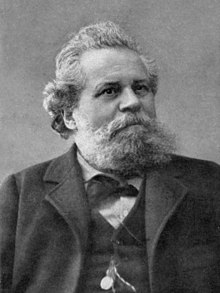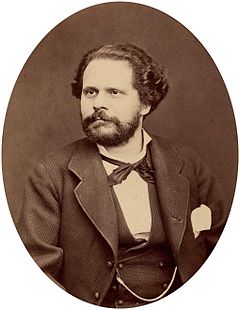Giosuè Carducci
Giosuè Carducci | |
|---|---|
 | |
| Born | Giosuè Alessandro Giuseppe Carducci (1835-07-27)27 July 1835 Valdicastello di Pietrasanta, Tuscany, Italy |
| Died | 16 February 1907(1907-02-16) (aged 71) Bologna, Italy |
| Occupation | Poet |
| Nationality | Italian |
| Notable awards | Nobel Prize in Literature 1906 |
Giosuè Alessandro Giuseppe Carducci (Italian: [dʒozuˈɛ kkarˈduttʃi]; also Giosue Carducci [ˈdʒɔːzu.e karˈduttʃi] in later years;[1] 27 July 1835 – 16 February 1907) was an Italian poet, writer, literary critic and teacher. He was very influential[2] and was regarded as the official national poet of modern Italy.[3] In 1906 he became the first Italian to receive the Nobel Prize in Literature[4] "not only in consideration of his deep learning and critical research, but above all as a tribute to the creative energy, freshness of style, and lyrical force which characterize his poetic masterpieces".[5]
Contents
1 Biography
2 Works
2.1 Juvenilia
3 See also
4 Notes
5 References
6 External links
Biography

He was born in Valdicastello (part of Pietrasanta), a small town in the Province of Lucca in the northwest corner of the region of Tuscany. His father, a doctor, was an advocate of the unification of Italy and was involved with the Carbonari. Because of his politics, the family was forced to move several times during Carducci's childhood, eventually settling for a few years in Florence.[6]
From the time he was in college, he was fascinated with the restrained style of Greek and Roman Antiquity, and his mature work reflects a restrained classical style, often using the classical meters of such Latin poets as Horace and Virgil. He translated Book 9 of Homer's Iliad into Italian.
He graduated in 1856 from the Scuola Normale Superiore di Pisa and began teaching school. The following year, he published his first collection of poems, Rime. These were difficult years for Carducci: his father died, and his brother committed suicide.
In 1859, he married Elvira Menicucci, and they had four children. He briefly taught Greek at a high school in Pistoia, and then was appointed Italian professor at the university in Bologna. Here, one of his students was Giovanni Pascoli, who became a poet himself and later succeeded him at the university.
Carducci was a popular lecturer and a fierce critic of literature and society. He was an atheist,[7] whose political views were vehemently hostile to Christianity generally and the Catholic Church in particular.
I know neither truth of God nor peace with the Vatican or any priests. They are the real and unaltering enemies of Italy.
he said in his later years.[8]
This anti-clerical revolutionary vehemence is prominently showcased in one famous poem, the deliberately blasphemous and provocative "Inno a Satana" (or "Hymn to Satan".) The poem was composed in 1863 as a dinner party toast, published in 1865, then republished in 1869 by Bologna's radical newspaper, Il Popolo, as a provocation timed to coincide with the First Vatican Council, a time when revolutionary fervor directed against the papacy was running high as republicans pressed both politically and militarily for an end of the Vatican’s domination over the papal states.[9]
In 1890 he met future writer and poet Annie Vivanti, with whom he started a love affair. Carlo Emilio Gadda reported that
.mw-parser-output .templatequote{overflow:hidden;margin:1em 0;padding:0 40px}.mw-parser-output .templatequote .templatequotecite{line-height:1.5em;text-align:left;padding-left:1.6em;margin-top:0}
Carducci used to travel with a suitcase in which he kept a huge pair of Annie Vivanti's panties... every once in a while, he opened the suitcase, took out the panties, sniffed them and got intoxicated from them.[10][11]
In 2004, the uncensored letters between her and Carducci were published.[10][12]
While "Inno a Satana" had quite a revolutionary impact, Carducci's finest poetry came in later years. His collections Rime Nuove (New Rhymes) and Odi Barbare (Barbarian Odes) contain his greatest works.[13]
He was the first Italian to receive the Nobel Prize in Literature, in 1906. He was also elected a Senator of Italy.[14] In politics he remained a strong Liberal throughout his life, although he vacillated between a preference for republicanism and constitutional monarchy.[15] Although his reputation rests primarily on his poetry, he also produced a large body of prose works.[16] Indeed, his prose writings, including literary criticism, biographies, speeches and essays, fill some 20 volumes.[17] Carducci was also an excellent translator and translated some of Goethe and Heine into Italian.
The Museum of the Risorgimento, Bologna is housed in the Casa Carducci, the house where he died at the age of 71, and contains an exhibits on the author.
Works
It is not always easy to follow the development of Carducci's poetry through the collections he edited. The poet in fact organized his compositions several times and in different ways and gave a definitive arrangement only later in the edition of his Opere published for Zanichelli between 1889 and 1909. The following is a list of poetic works published in one volume, then rearranged into the 20 volumes of his Opere.
Rime, San Miniato, 1857.
Levia Gravia, 1868.
Poesie, Firenze, Barbera, 1871.
Primavere elleniche, 1872.
Nuove poesie, 1873.
Odi barbare, 1877.
Juvenilia, 1880.
Levia Gravia, 1881.
Giambi ed Epodi, 1882.
Nuove odi barbare, 1882.
Rime nuove, 1887.
Terze odi barbare, 1889.
Delle Odi barbare. Libri II ordinati e corretti, 1893.
Rime e ritmi, 1899.
Poesie. MDCCCL-MCM, 1901.
Below are the poetic volumes in the Opere. The volumes, however, do not correspond to the chronological order with which the poet had published his first collections, but refer more than anything else to the distinctions of genres and therefore we find poems of the same period in different collections. The collections follow this order:
Juvenilia, in six books, 1850-1860
Levia Gravia, in two books, 1861-1871
Inno a Satana, 1863
Giambi ed Epodi, in two books, 1867-1879
Intermezzo, 1874-1887
Rime Nuove, in nine books, 1861-1887
Odi barbare, in two books, 1873-1889
Rime e Ritmi, 1889-1898
Della Canzone di Legnano, Part I, 1879
Juvenilia
The first collection of lyrical poems, which Carducci collected and divided in six books under the title Juvenilia (1850-1860), is undoubtedly inspired by the classical tradition of the Amici pedanti group that was constituted at that time for the purpose of fighting the romanticism of the Florentines. In the verses of the collection we can immediately see his imitation of the ancient classics, of the stilnovo style, of Dante and Petrarch and, among the moderns, Vittorio Alfieri, Monti, Foscolo and Leopardi.
But the Carduccian spirit is already visible; his love for the beauty of style, the purity of sentiments and the celebration of liberty, as well as the ability to appreciate all that is genuine, therefore also the language of the common people.[15][18]
See also
- Jessie White Mario
Notes
^ Giosuè in DOP
^ Baldi, Giusso, Razetti, Zaccaria, Dal testo alla storia. Dalla storia al testo, Torino, 2001, vol. 3/1B, p. 778: "Partecipò intensamente alla vita culturale del tempo e ... sostenne infinite polemiche letterarie e politiche".
^ Giulio Ferroni, Profilo storico della letteratura italiana, Torino, 1992, p. 780: "Si trasforma in poeta ufficiale dell'Italia umbertina".
^ "Giosue Carducci | Italian poet". Encyclopædia Britannica. Retrieved 22 August 2017..mw-parser-output cite.citation{font-style:inherit}.mw-parser-output .citation q{quotes:"""""""'""'"}.mw-parser-output .citation .cs1-lock-free a{background:url("//upload.wikimedia.org/wikipedia/commons/thumb/6/65/Lock-green.svg/9px-Lock-green.svg.png")no-repeat;background-position:right .1em center}.mw-parser-output .citation .cs1-lock-limited a,.mw-parser-output .citation .cs1-lock-registration a{background:url("//upload.wikimedia.org/wikipedia/commons/thumb/d/d6/Lock-gray-alt-2.svg/9px-Lock-gray-alt-2.svg.png")no-repeat;background-position:right .1em center}.mw-parser-output .citation .cs1-lock-subscription a{background:url("//upload.wikimedia.org/wikipedia/commons/thumb/a/aa/Lock-red-alt-2.svg/9px-Lock-red-alt-2.svg.png")no-repeat;background-position:right .1em center}.mw-parser-output .cs1-subscription,.mw-parser-output .cs1-registration{color:#555}.mw-parser-output .cs1-subscription span,.mw-parser-output .cs1-registration span{border-bottom:1px dotted;cursor:help}.mw-parser-output .cs1-ws-icon a{background:url("//upload.wikimedia.org/wikipedia/commons/thumb/4/4c/Wikisource-logo.svg/12px-Wikisource-logo.svg.png")no-repeat;background-position:right .1em center}.mw-parser-output code.cs1-code{color:inherit;background:inherit;border:inherit;padding:inherit}.mw-parser-output .cs1-hidden-error{display:none;font-size:100%}.mw-parser-output .cs1-visible-error{font-size:100%}.mw-parser-output .cs1-maint{display:none;color:#33aa33;margin-left:0.3em}.mw-parser-output .cs1-subscription,.mw-parser-output .cs1-registration,.mw-parser-output .cs1-format{font-size:95%}.mw-parser-output .cs1-kern-left,.mw-parser-output .cs1-kern-wl-left{padding-left:0.2em}.mw-parser-output .cs1-kern-right,.mw-parser-output .cs1-kern-wl-right{padding-right:0.2em}
^ "Vita, opere e poetica di Giosuè Carducci" (in Italian). 13 June 2014. Retrieved 5 August 2016.
^ Chisholm, Hugh, ed. (1911). . Encyclopædia Britannica. 5 (11th ed.). Cambridge University Press.
Chisholm, Hugh, ed. (1911). . Encyclopædia Britannica. 5 (11th ed.). Cambridge University Press.
^ Biagini, Mario, Giosuè Carducci, Mursia, 1976, p. 208.
^ Carelle, A., Naturalismo Italiano, Draghi, Padova 1911, cited at http://www.infidels.org/library/historical/joseph_mccabe/dictionary.html
^ Carducci, Giosuè, Selected Verse/ Giosuè Carducci: edited with a translation, introduction and commentary by David H. Higgins, (Aris & Phillips; Warminster, England), 1994. See also: Bailey, John Cann, Carducci The Taylorian Lecture (Clarendon Press, Oxford) 1926.
^ ab "Annie e l' Orco: storie d' amore e cinismo". Corriere della Sera. 2005....immagine ribadita e documentata l' anno scorso con l' uscita da Feltrinelli di Addio caro Orco : il carteggio integrale tra i due, senza tagli e censure moralistiche dell' edizione di Pietro Pancrazi (1951) che aveva acquistato lettere e diari dalla vedova del poeta.
^ Cattaneo, Giulio (1991). Il gran lombardo. p. 40.Carducci viaggiava con una valigia dove era un paio di enormi mutande di Annie Vivanti, con giri di merletti e svoli a insalata. Ogni tanto apriva la valigia, tirava fuori le mutande, le annusava e se ne inebriava. Questo è feticismo
^ Addio caro Orco (2004), published by Feltrinelli
^ One prominent English translation is The Barbarian Odes of Giosuè Carducci, translated from the Italian by William Fletcher Smith, (Manasha, Wisconsin: George Banta Publishing Co., 1939). The translation is reviewed in Dismukes, William Paul (March 1940). "The Barbarian Odes of Giosuè Carducci by William Fletcher Smith". Italica. 17 (1): 29–30.
^ Scalia, Samuel Eugene (1937). Carducci. New York: S.F. Vanni.
^ ab Bickersteth, Geoffrey Langdale (1913). Carducci. London: Longmans, Green. p. 14.
^ Tomasin, LorenzoLorenzo Tomasin (2007). "Classica e odierna". Studi sulla lingua di Carducci. Florence: Olschki.
^ Selections from Carducci; Prose and Poetry with introduction, notes and vocabulary by A. Marinoni. New York: William R. Jenkins. 1913. vii–ix.
^ G. Bertoni, La lingua poetica di Giosue Carducci, in Regia Università di Bologna, cit., pp.91-95
References
- Nobel Prize Presentation Speech
External links
| Wikimedia Commons has media related to Giosuè Carducci. |
| Wikiquote has quotations related to: Giosuè Carducci |
- Nobel Prize Biography page
Works by or about Giosuè Carducci at Internet Archive
Works by Giosuè Carducci at LibriVox (public domain audiobooks)
- Carducci: all the poems
Giosuè Carducci poems Original Italian text